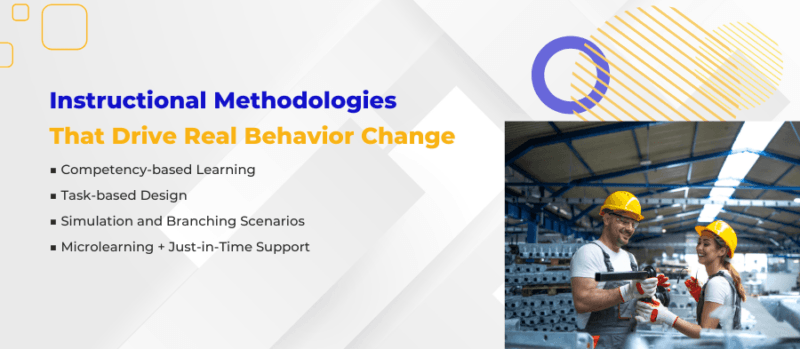Blending eLearning: A Smarter Approach
In today's manufacturing landscape, products are getting smarter, software is evolving fast, and customer expectations are sky-high. Field sales and service teams are often on the frontlines of this transformation.
Yet, many manufacturing companies are still relying on outdated training methods: lengthy manuals, sporadic ride-alongs, or dense classroom sessions that don't stick.
To empower field teams at scale, companies need modern, blended eLearning curriculums tailored for product and software training. These solutions must be mobile, adaptive, and anchored in real-world scenarios.
Training Gap In Field Sales And Service
Imagine a manufacturer launching a new line of industrial compressors. Sales teams need to explain specs, configurations, and value propositions to engineers and procurement heads. Service techs must install and calibrate them flawlessly.
Now add complexity: regional variants, software integrations, compliance protocols, and tight service SLAs. One knowledge gap in the field can mean lost revenue, frustrated customers, or equipment failure.
Field reps don't have time for long courses. They need learning that is relevant, bite-sized, and immediately applicable.
What A Modern Product Training Curriculum Looks Like
A well-structured eLearning curriculum for field sales and service teams is more than a digital handbook. Technical training has to be a dynamic system that empowers learners to absorb, apply, and adapt technical knowledge in real-time customer contexts. The ideal curriculum is modular, mobile-friendly, responsive to role differences, and deeply rooted in the actual flow of work.
Here's what such a curriculum typically includes.
1. Core Product Knowledge
At the foundation are short, high-impact microlearning videos that explain product features, specifications, use cases, and key differentiators. These modules should answer critical questions like: What does this product do? Who is it for? How does it outperform competitors? Sales reps use this to pitch value. Service teams use it to understand system logic.
2. Scenario-Based Selling
For sales teams, training must include simulated conversations with customers. Interactive decision trees and branching scenarios allow reps to handle common objections, customize solutions, and navigate procurement discussions. These simulations improve confidence and reinforce consultative selling techniques.
3. Field Service Tasks
Service technicians benefit from guided walkthroughs of installation, calibration, troubleshooting, and repair. These can include annotated diagrams, interactive toolkits, and real-time video support. These resources double as training and just-in-time performance support tools.
4. Instructor-Led Touchpoints
Complex products or niche features still require human-led demos. Live or virtual sessions provide opportunities to ask product experts questions, practice in small groups, or troubleshoot rare cases. These sessions also strengthen the human connection with HQ, building morale and feedback loops.
5. Certification And Assessments
To validate readiness, a modern curriculum must include practical assessments aligned to real-world challenges. Role-specific evaluations ensure that both sales and service reps meet minimum thresholds of confidence and competence before they engage with customers.
Case In Point
A global HVAC company rolled out a mobile-first product training suite for service engineers and sales reps across 14 countries. Warranty claims dropped by 23% and cross-selling increased by 17% in just 6 months.
Methodologies That Boost Performance
Behind every successful product training curriculum is a set of instructional methodologies that drive real behavior change in the field. These aren't just academic principles; they translate directly into better sales conversations, faster service calls, and more confident reps.

Image by CommLab India
Competency-Based Learning
Traditional training often stops at knowledge recall. But in field sales and service, knowing isn't enough—reps must be able to do. Competency-based learning ensures that training outcomes are measured by demonstrated ability.
For sales reps, that might mean confidently explaining ROI calculations during a pitch. For service engineers, it could involve accurately calibrating a product onsite without supervision. Assessments should reflect job performance, not just quiz scores.
Task-Based Design
Forget abstract modules titled "Product Overview." Field teams learn best when training is structured around real-world workflows. That means designing learning paths aligned with the actual sequence of tasks reps perform, such as qualifying a lead, handling an objection, assembling a part, or resolving an error code. Task-based design increases relevance, reduces time to proficiency, and improves transfer to the job.
Simulation And Branching Scenarios
Scenarios transform static knowledge into dynamic skill. For sales, this could be a branching dialogue with a skeptical procurement officer. For service, it might involve choosing the right fix based on evolving symptoms. These simulations allow learners to make decisions, experience consequences, and build muscle memory in a risk-free environment.
Example: A medical device company created a virtual hospital simulation where reps navigated complex procurement scenarios with surgeons and hospital administrators. The result? Shorter sales cycles and stronger customer relationships.
Microlearning And Just-In-Time Support
Field teams are busy. They need content they can access during a break, at a job site, or right before a client visit. Microlearning modules (2–5 minutes each) focus on a single topic or task. Just-in-time support includes checklists, video explainers, and mobile job aids that act as performance boosters, not just learning tools.
Together, these methodologies create a practical, flexible, and effective learning experience. They align perfectly with the rhythm of fieldwork—fast, varied, and customer-facing—and help ensure that training doesn't just check a box but actually drives performance where it matters most.
AI-Enabled Personalization For Field Readiness
AI is no longer a futuristic add-on in L&D; it's a core driver of scalable, tailored, and responsive training programs, especially for dispersed field teams. In product training for sales and service roles, AI enables a level of precision that traditional methods can't match.
Adaptive Learning
Field reps come with varying levels of experience, confidence, and learning speed. AI-driven adaptive platforms assess a learner's inputs, performance, and preferences to create personalized learning paths.
An experienced sales engineer might skip foundational modules and dive straight into competitive positioning or advanced integrations.
Meanwhile, a new hire might receive extra reinforcement and scenario-based coaching. This approach accelerates learning for top performers while supporting slower learners without holding anyone back.
Language Localization
Global teams demand global solutions. AI-powered translation tools now offer context-aware localization that preserves technical accuracy and intent. Instead of waiting weeks for human translators, companies can roll out product updates in multiple languages within days.
This ensures that reps across India, Mexico, Germany, and Brazil all get consistent messaging and training, reducing confusion and increasing compliance.
Smart Analytics
AI tools don't just personalize content—they offer deep insights into learning behavior. Smart analytics track which modules are skipped, where learners struggle, and how long it takes them to complete specific tasks.
This enables L&D teams to intervene proactively. If 40% of reps are missing a step-in compressor installation, that's a red flag before it becomes a warranty issue.
Predictive Readiness Models
Some advanced platforms use AI to predict field readiness by analyzing past training behavior, assessment performance, and job data. Managers can then make data-backed decisions about who is ready for field deployment or needs additional coaching.
Example: A pump manufacturer used AI to identify that many service reps were repeatedly missing key installation steps in their assessments. A targeted refresher module was deployed, resulting in a 40% drop in product callbacks within 90 days.
ILT As A Strategic Layer
In an era dominated by digital learning, Instructor-Led Training (ILT) has evolved from being the default mode of delivery to becoming the strategic glue in a blended learning experience. While eLearning and AI-driven modules provide scale and efficiency, ILT delivers depth, personalization, and human connection that field teams crave and often need.

Image by CommLab India
Live training is indispensable in key moments:
- New product launches or major updates. When a new product hits the market, it's not just about understanding features. Reps need the confidence to pitch, demo, and troubleshoot in front of high-stakes clients. ILT allows for direct interaction with product experts and hands-on experience.
- Soft skills development. Consultative selling, conflict resolution, and customer negotiation can't be mastered through a screen. ILT provides the role-play, coaching, and feedback loops required to build real-world confidence.
- High-value client scenarios or complex solutions. When the stakes are high, such as deploying a multi-million-dollar system or dealing with a critical service contract, ILT offers a safe space to rehearse, test assumptions, and learn from peers.
ILT also bridges the emotional gap. It humanizes the learning experience, fosters relationships with peers and mentors, and reinforces a shared sense of mission across teams spread across regions or time zones.
Example: A telecom equipment firm used eLearning to train reps on specs and installation steps but reserved ILT bootcamps for handling objections and conducting price-value conversations. The result? Reps closed deals faster and reported higher confidence levels during in-person negotiations.
Rather than delivering product specs in a classroom, which eLearning can do efficiently, ILT should focus on practice, discussion, and judgment-based learning. This includes labs, expert panels, mock demos, scenario rehearsals, and debriefs that simulate the real pressures of the field.
When integrated intentionally, ILT transforms from a legacy burden to a high-impact differentiator. It ensures that reps are not just trained but ready to perform with conviction, clarity, and human insight.
Engagement Tactics That Actually Work
Even the most well-designed training will fall flat if it doesn't capture and sustain attention. Engagement isn't a luxury in field sales and service training, it's a requirement. Reps are on the move, under pressure, and juggling competing priorities. Your curriculum must work in their world, not just yours.
Here are 5 proven engagement tactics that translate into better learning outcomes and stronger performance in the field:
- Use real sales and service stories. Case studies and first-person accounts of success and failure in the field create emotional resonance and practical relevance. Reps perk up when they hear how a colleague salvaged a deal or solved an impossible service issue. These stories also build a learning culture grounded in authenticity and peer respect.
- Mobile-first design. Design your content to be consumed on smartphones and tablets. Field teams often learn during travel, between customer visits, or even on-site. Responsive design, voice-narrated videos, and low-bandwidth access are non-negotiables.
- Gamify progress. Introduce progress bars, badges, timed challenges, and leaderboards. Healthy competition motivates completion and reinforces knowledge retention. Gamification turns routine modules into opportunities for recognition and reward. Even simple mechanics like unlocking new levels or earning digital certificates can drive engagement.
- Field mentoring and peer coaching. Blend digital learning with live touchpoints from seasoned reps. A quick debrief after a customer visit or a shared tip during a service call can turn abstract lessons into applied insights. Pairing new hires with mentors also builds culture and accelerates onboarding.
- Social learning. Facilitate peer discussion boards, user-generated videos, and shared playbooks. Encourage reps to contribute their own troubleshooting hacks, negotiation talk tracks, or demo scripts. This turns training into a two-way conversation and reinforces that expertise exists not just at HQ, but throughout the field.
Final Word: Equip The Frontline, Don't Overload Them
Your field sales and service teams represent your brand, your product, and your promise. They deserve training that respects their time, adapts to their reality, and equips them for the moments that matter. When you combine adaptive eLearning, task-based design, and meaningful human touchpoints, you create not just better learners, but stronger customer experiences.









